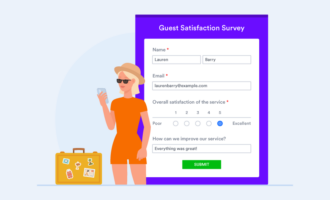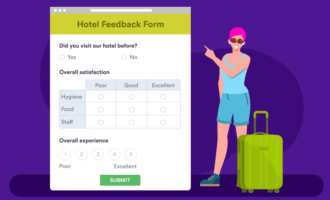12 pricing survey questions
- How familiar are you with the product?
- How frequently do you purchase the product?
- What do you like most and least about the product?
- What price would you expect to pay for the product if you bought it today?
- If you knew the price of the product was [price], would you be willing to buy it?
- What is the most you would be willing to pay for the product?
- At what point would the price for the product be so low that you would question its quality?
- At what point would the price for the product seem like a good deal?
- At what point would the price of the product seem a little too high?
- At what point would the price of the product be so high that you wouldn’t buy it?
- After reading about this product, how likely are you to purchase it for [amount]?
- If you were shopping for a particular product, which of the following combinations of features and price?
Product, price, place, and promotion — these are four factors that determine a company’s sales success. You can have a great product that’s easy to purchase and compellingly promoted, but if it isn’t priced appropriately, you might not get the sales you expect.
Pricing is tricky to navigate. The price for a product or service has to appeal to customers while still generating value for the company. To hit this sweet spot, more companies are conducting pricing surveys to better understand their markets.
Use this guide to learn how to develop pricing survey questions so you can sell your products at a price your customers will appreciate.
An overview of pricing surveys
A pricing survey is a research tool that allows businesses to collect insight from consumers to determine the optimal price for products or services.
By asking customers targeted pricing survey questions, businesses can collect data on how much customers are willing to pay, how they perceive the value of a product or service, and what impact different features may have on their purchasing decisions. Survey results can help businesses optimize prices for maximum sales, customer satisfaction, and profits.
Because this research is so complex, survey administrators have developed a number of different pricing survey methods to gather the most valuable insight from participants, depending on the situation. Four of these methods, which will be discussed in detail later, are
- Willingness to pay
- Van Westendorp Price Sensitivity Meter
- Gabor-Granger
- Conjoint analysis
Each pricing survey method can provide valuable information businesses can use to effectively price their products. Surveys can focus on a particular method or integrate multiple methods.
The importance of pricing surveys
Using pricing surveys can help you ensure that your customers’ perception of your product’s value aligns with its price. If your price doesn’t match consumer expectations, you could see lower sales than anticipated, or you could be leaving money on the table.
Pricing surveys can help you pinpoint the pricing range that you can reasonably charge for a product while also helping you learn about your customers. They’re useful for both business-to-consumer (B2C) products and business-to-business (B2B) services, software, and systems.
Your pricing strategy will vary depending on the customer and product. It can also vary based on outside economic factors — which means your pricing survey from three years ago could be outdated depending on how today’s economy compares to the economic conditions the last time you conducted a survey.
It’s also important to consider the potential long-term consequences of price changes based on feedback. How will a price change affect the long-term profitability of an item?
Pricing survey methods
You don’t have to reinvent the wheel when it comes to pricing survey questions. Here’s a breakdown of frequently used pricing survey methods.
Benchmark questions
To properly contextualize customer responses, it’s important to ask customers some introductory questions about their relationship to a product or service. Once you’ve asked questions to establish your customers’ familiarity with a product, you can get into the weeds of the pricing survey.
Willingness to pay
This pricing survey method helps administrators determine the maximum price customers are willing to pay for a product or service. Pricing survey questions should take a direct approach and clearly ask respondents their price preferences.
Willingness to pay questions can ask about the range of prices customers are willing to pay and customer expectations around price. Asking different customer demographics the same willingness to pay questions can highlight how different consumer groups see the value of the product.
Van Westendorp Price Sensitivity Meter
Van Westendorp Price Sensitivity Meter questions help survey administrators identify a series of critical price points for a product or service by asking customers key questions about their perceptions of price and value. Responses are then plotted on a graph to illustrate the range of acceptable pricing.
Gabor-Granger
This pricing survey method assesses the price elasticity of demand by asking respondents how likely they are to purchase a product at various price points. This helps administrators identify the optimal price for a product or service by plotting demand and revenue curves to highlight the price that maximizes revenue.
You can ask about the likelihood of purchase multiple times within your survey, changing the price point each time and analyzing results to find the best price for your product or service.
Conjoint analysis
This is a statistical technique that helps determine how customers value different features of a product, including price. The survey presents participants with various combinations of product attributes and asks them to choose between them. Participants can also look at a table with product features and price points and choose the most appealing combination.
Trends among responses help identify the product features that most influence purchasing decisions. This method provides insights into the trade-offs customers are willing to make and helps businesses optimize product design and pricing strategies.
12 pricing survey questions to ask
Here are twelve examples of pricing survey questions. Each question aligns with one of the methods or types mentioned above. You can modify the questions based on your product, service, or industry.
- Benchmark question: How familiar are you with the product?
- Benchmark question: How frequently do you purchase the product?
- Benchmark question: What do you like most and least about the product?
- Willingness to pay question: What price would you expect to pay for the product if you bought it today?
- Willingness to pay question: If you knew the price of the product was [price], would you be willing to buy it?
- Willingness to pay question: What is the most you would be willing to pay for the product?
- Van Westendorp question: At what point would the price for the product be so low that you would question its quality?
- Van Westendorp question: At what point would the price for the product seem like a good deal?
- Van Westendorp question: At what point would the price of the product seem a little too high?
- Van Westendorp question: At what point would the price of the product be so high that you wouldn’t buy it?
- Gabor-Granger question: After reading about this product, how likely are you to purchase it for [amount]?
- Conjoint analysis question: If you were shopping for a particular product, which of the following combinations of features and price points would be most appealing to you?
Best use cases for each pricing survey method
Each organization’s goals for a pricing survey are unique. What’s important is identifying the kind of data you need and choosing the method best suited for collecting that kind of data. These are typically the best use cases for each pricing survey method:
- The willingness to pay method is ideal for situations where you have an existing, well-defined product and want to better understand its perceived value in the marketplace.
- The Van Westendorp method is best suited for determining the ideal price range for maximizing the sales, desirability, and profit of a well-defined product or service.
- The Gabor-Granger method is ideal for scenarios where both your product and the overall price range are well-defined, but you still need to determine the optimal price within that range to maximize sales.
- Conjoint analysis can help when you have multiple product options and want to determine how different combinations of options impact perceived value, which options are most valued, and how much customers are willing to pay for those options.
Tips for conducting effective pricing surveys
Developing pricing survey questions is just the first step toward building an effective survey. There are also ways to increase the chances of receiving accurate, actionable data. Here are a few things to consider:
- Determine the best question formats for respondents. You might want to use a mixture of multiple-choice and open-ended questions to gather both quantitative and qualitative data.
- Decide whether you want to focus on your specific product or a generic type of product. Your pricing survey might focus on a general product offering (e.g., productivity software, shampoo, etc.) or on the perceptions of your specific product.
- Focus on the most useful survey audience. Choose your survey audience based on your goals. Do you want to see how occasional customers perceive value and learn how you can turn them into repeat customers? Do you want to learn how possible future customers perceive your products and prices, and if you need to adjust your prices to win their business?
- Test your survey for leading questions. Make sure your statements aren’t guiding respondents to specific answers that could skew your data.
Evaluate the length of your survey. Having too many questions can discourage participants from completing your survey. This is sometimes referred to as survey fatigue. If your questionnaire is too long, respondents may abandon it or stop answering thoughtfully.
Powerful pricing surveys with Jotform
Once you know how to develop pricing survey questions, you just need the right platform to build your survey, share it, and study the results.
Jotform is a powerful survey-building tool. Using a simple drag-and-drop interface, you can build surveys from scratch or customize one of over 2,000 existing survey templates. Add questions (choose from a variety of field types, like multiple-choice questions, rating scales, open-ended questions, input tables, and more), customize the survey’s design and branding, and share it with an email, a link, a website embed, a social media post, or a QR code.
Jotform automatically generates customizable visual reports from survey submissions, letting you easily analyze the data you gather and develop pricing strategies based on it.
Try out Jotform today and see how our survey tools can help you.






































































































Send Comment: